|
|
|
| My Favourite Planet > English > Middle East > Turkey > Ephesus > photo gallery |
| Ephesus, Turkey |
Ephesus photo gallery 1 |
 |
 |
21 of 62 |
 |
 |
|
| |
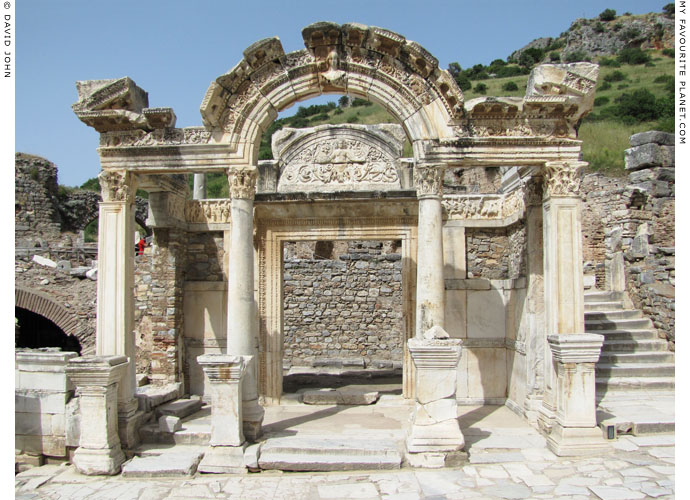
The "Temple of Hadrian", 2nd century AD, on the north side of Kuretes Street, Ephesus. |
| |
The "Temple of Hadrian"
Part 1: introduction and history
What visitors today see of the so-called "Temple of Hadrian" is merely the entrance porch, reconstructed by archaeologists in the 1950s. The highly ornate portico was covered with intricate marble sculptural reliefs and inscriptions. The decoration of the cella, the main room of the temple in which a statue stood, has not survived.
The architectural form of the temple is described to as prostyle tetrastyle in antis, that is with a pronaos (front porch) supported by four columns at the front and walls along either side. The cella was 7.50 metres wide, 5 metres long, and had a barrel-vaulted roof.
Two low steps lead from the sloped street to the porch. The facade's entablature, consisting of 23 marble blocks, is topped with a pediment, only the corners of which have survived, in the centre of which is an arch. This combination of arch and pediment is thought to have originated in the Near East, and the style is often referred to as Syrian. A relief bust of the Greek goddess Tyche (see photo below) decorates the keystone of the arch. The entablature is supported by pillars at each end and two unfluted monolithic coulmns at the centre, below each end of the arch. All four supports, which form a triple entrance, stand on low pedestals and have composite capitals with reliefs of acanthus leaves and figures. In front of each stands a tall statue base (see below).
At the back and right side of the porch are stone walls, the lower parts of which are covered by marble. The wall on the left side has been broken through as a further entrance with two steps. In the middle of the back wall is a wide doorway with a decorated marble frame. This led to the cellar of the temple in which is thought to have stood a statue of Emperor Hadrian. Above the doorway is a marble lunette panel decorated by a relief, which is believed to depict the Gorgon Medusa (see photos below).
Along the top of the back and side walls, at the level of the top of the doorframe, is a frieze of four marble reliefs representing scenes from the history and founding legends of Ephesus (see gallery pages 22-24). It was not originally part of the "Temple of Hadrian", and it is thought that it was made in the third quarter of the 4th century AD for an another unknown building, and added to the temple shortly after, perhaps between 383 and 387 AD in the reign of Emperor Theodosius I (379-395 AD), during its restoration following an earthquake. The original form of the frieze and the order of the relief scenes (perhaps a single continuous frieze) is unknown, and there may have been further scenes or panels. [1] The carving is not of the best quality and many figures are badly damaged and worn. Few of the individual figures represented have been identified beyond doubt.
On the left side of the porch are two reliefs showing mythical and legendary figures and scenes, one including at least one depiction of Androklos, the legendary founder of Ephesus (gallery page 22). The two reliefs on the right side also show groups of mythical figures, one thought to depict Amazons fleeing from Dionysus and his retinue (gallery page 23), and the other perhaps the Byzantine Emperor Theodosius I and members of his family (gallery page 24). All the frieze reliefs displayed on the temple are copies; the originals are in the Ephesus Archaeological Museum, Selçuk.
The building was discovered 1956 during excavations by the Austrian Archaeological Institute led by Franz Miltner (1901-1959) [2], and the porch was reconstructed 1957-1958 by Miltner with the architect Karl Heinz Göschl, using the surviving architectural members, as well as some modern building materials. During an extensive conservation project by the Austrian Archaeological Institute the stonework was cleaned and restored in 2013-2014. [3]
It was named the "Temple of Hadrian" due to an interpretation of the inscription dedicating the building to the emperor (reigned 117-138 AD).
[Ἀρτέμιδι Ἐφεσίᾳ καὶ Αὐτοκράτορι Καίσα]ρι Τραιανῶι Ἁδριανῶι Σεβαστῶ[ι] καὶ τῶι νεωκόρωι Ἐφεσί[ων δήμ]ωι Πόπλιος Κυιντίλιος Ποπλίου υἱὸς Γαλερία [Οὐάλης Οὐάριος — σὺν — τῇ γυναι]κὶ καὶ Οὐ[α]ρίλλῃ θυγα[τ]ρὶ τὸν ναὸν ἐκ θεμελίων σὺν παντὶ τῶι κόσμωι καὶ τὸ ἐν αὐτ[ῷ ἄγαλμα ἐκ] τῶν ἰδίων ἀνέθηκεν, ἐπὶ ἀνθυπάτου Σερβαίου Ἰννόκεντος, γραμματεύοντος τοῦ δήμου τὸ βʹ Ποπλίου Οὐηδίο[υ Ἀν]τωνείνου ἀσιάρχου, ὑποσχομένου δὲ ἐπὶ Τί(του) Κλαυδίου Λουκκ[ειανοῦ γραμματέω]ς τοῦ δήμου.
Inscription Ephesos 290 (= IEph 429) at The Packard Humanities Institute.
The inscription states that the temple, dedicated to Artemis Ephesia, Imperator Caesar Traianus Hadrianus Augustus and the neokoros, the Ephesian demos (the people), was built from the ground up, with all its decoration and the statue inside, at the expense of Publius Quintilius (Valens Varius), son of Publius of the Galeria tribe, with his wife and their daughter Varilla, when Servaeus Innocens was proconsul of Asia and Publius Vedius Antoninus (perhaps M. Claudius Publius Vedius Antoninus Sabinus) was grammateus (γραμματεύς, town clerk) of Ephesus for the second time and the asiarch (ἀσιάρχης, the high priest of the imperial cult in the province of Asia). The building of the temple had been promised when Ti. Claudius Luci[anus ?] was grammateus for the previous year. Although a statue (ἄγαλμα) is also mentioned, there is no indication of whom it represented.
The temple is thought to have been built in 117-118 AD, at the start of Hadrian's reign, although it has been argued that it may have been constructed later, perhaps some time between 133 and 138 AD. [4] There appears to be no evidence that the dedication of the building coincided with a visit by Emperor Hadrian to Ephesus. [5] The wealthy Ephesian citizen Varius also paid for the construction of the neighbouring "Varius Baths" (also known as the "Baths of Scholastikia") in the first half of the 2nd century AD, and Varius and Varilla are thought to have served some function at the Temple of Artemis.
At the time of its discovery Miltner believed that this was the official temple of the city's second term as Neokoros, for the imperial cult [6], granted to Ephesus by Hadrian himself around 130-133 AD. This has been doubted by several scholars on various grounds: for example that it was neither sufficiently grand nor in a suitably prominent location, and that the nature of the dedication and the assumed chronology rule it out. It has been suggested that the cult centre was a larger temple dedicated to Olympian Zeus and Hadrian (speculatively named the "Olympieion", "Olympieion of Hadrian" or even "Hadrianeion"), located elsewhere in or around the city. So far no such temple has been found, although the remains of a large structure dated to around the reign of Hadrian was discovered in 1972 near the Aghia Maria (Church of the Virgin Mary) at the northwest of the city. [7] Much of Ephesus has not yet been excavated and several other sanctuaries and monuments known or believed to have existed there also remain undiscovered.
According to a recent theory, this temple or shrine may have served as a station on the processional way between the Great Theatre and the Temple of Artemis, of which Kuretes Street was a part, at which Hadrian was ritually honoured, although necessarily not as an official part of the imperial cult. Yet other theories argue that the building was not a temple at all, but a propylon taken to Kuretes Street from the Olympieion [8], or was assembled using spolia taken from a number of other buildings.
The building is thought to have been restored a number of times, including at the end of the 4th century when the frieze was added (see above). It was probably also badly damaged by a massive earthquake in 262 AD and the sack of Ephesus by the Goths shortly after (262/263). It was rebuilt around 293-302 AD, when pedestals for statues of the Tetrarchs were placed in front of the porch. The inscribed pedestals of the statues of Diocletian, Constantius Chlorus and Galerius have survived, although none of the statues have been found. The statue of Maximian was replaced during the reign of Theodosius I (379-395 AD) by a statue of his father, Theodosius the Elder (Flavius Theodosius, also known as Comes Theodosius, circa 310-376 AD). [9] |
|
| |
| |
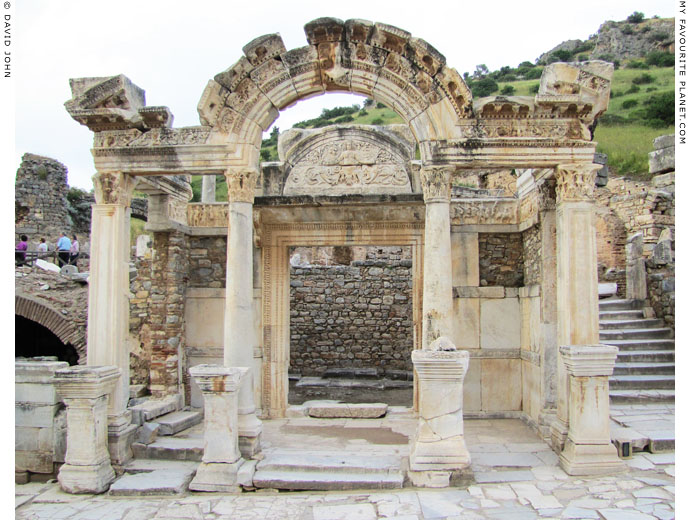
The reconstructed entrance porch of the "Temple of Hadrian". During the first reconstruction
in 1957-1958, restorers added modern architectural pieces, which look much fresher than the
more age-blackened originals, and imitate the mouldings but not the intricate carvings of the
facade (see a close-up of part of the facade on the next page).
This photo was taken in May 2013, just before the start of the most recent conservation
work by the Austrian Archaeological Institute in 2013-2014, during which the the entire
porch was taken apart, the stonework repaired, cleaned and reassembled [see note 3].
To the right of the temple is the stairway up to the entrance to
the "Baths of Scholastikia", also known as the "Baths of Varius". |
| |
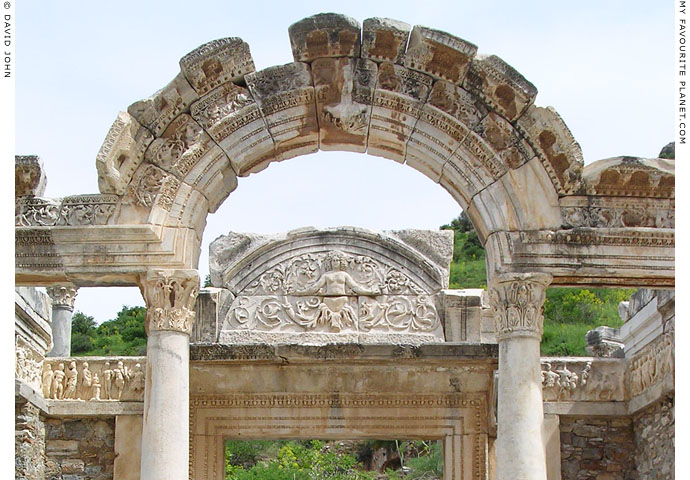
A relief bust of Tyche adorns the arch at the front of the porch of the
"Temple of Hadrian", and a relief of Medusa crowns the doorway behind. |
| |
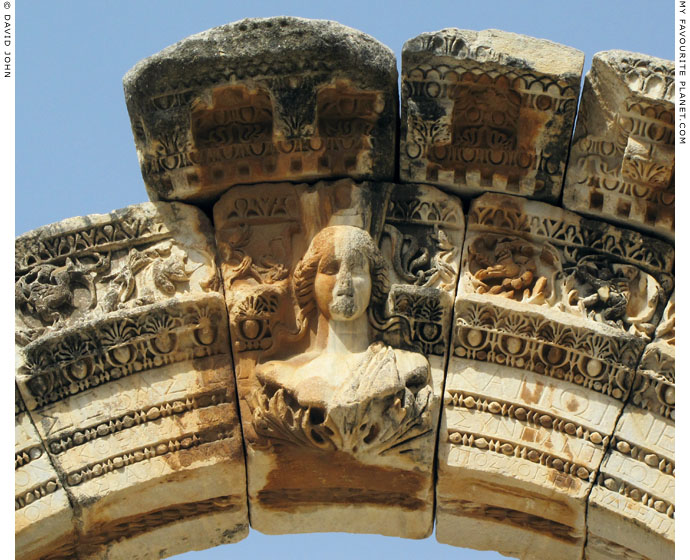
A relief bust of the goddess Tyche (her Roman equivalent was Fortuna) on the keystone
of the entrance archway to the "Temple of Hadrian" porch. She was seen as the protector
of cities and wears a mural crown depicting the walls and towers of a city. The finely
chiselled lettering of the dedicatory inscription can be seen to either side. |
| |
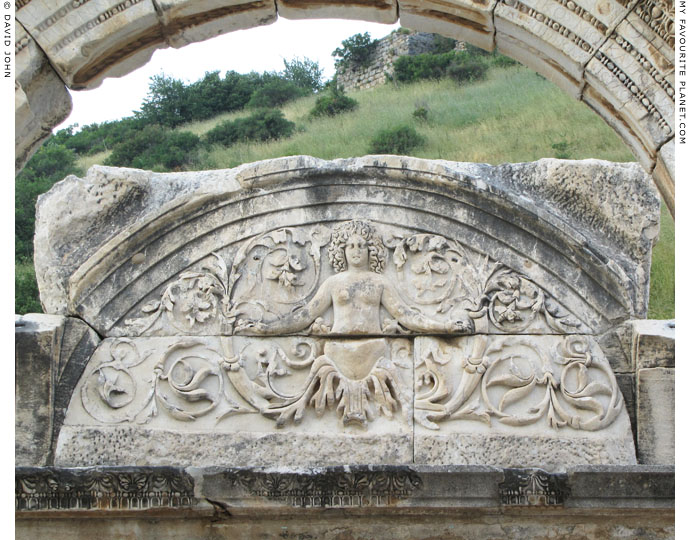
A relief of a figure which has been interpreted as the Gorgon Medusa
on a marble lunette panel above the doorway to the "Temple of Hadrian".
The naked female figure with wavy, snake-like hair and outstretched arms, is visible
to the top of her thighs. She stands in or emerges from the stem of a fabulous plant,
the branches of which spiral out symmetrically to either side of her. |
| |
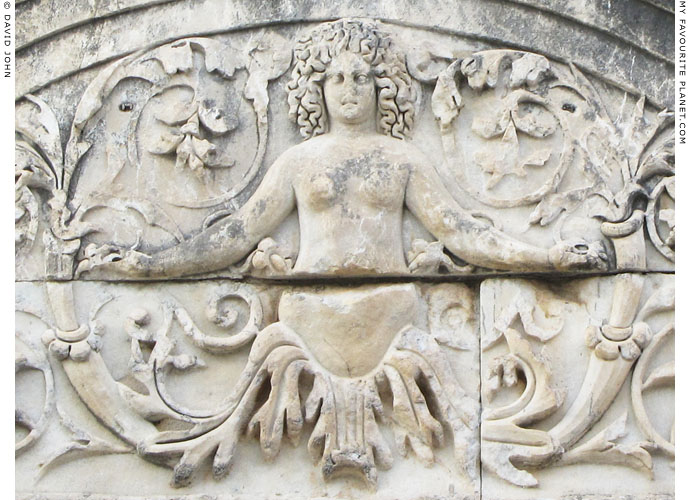
Gorgon Medusa in a plant above the doorway to the "Temple of Hadrian". |
| |
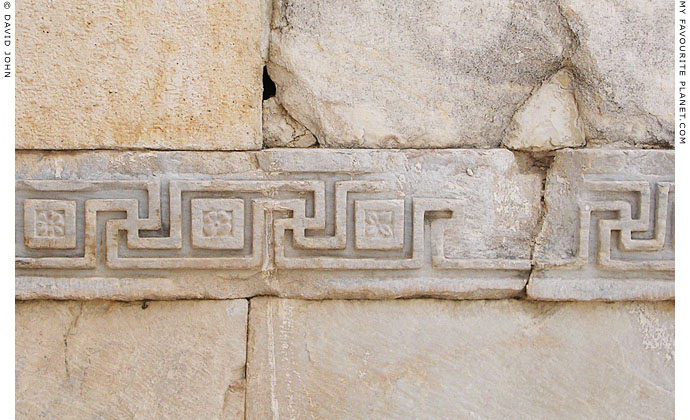
Decorative frieze inside the porch of the Temple of Hadrian.
|
| The apparently simple frieze has quite a refined design: a continuous meander pattern runs horizontally, with swastikas formed by intersections of the lines of the frame, interspersed by regularly-spaced small panels with varying floral motifs. A wonderful example of geometrical rhythm and fine chiselling by one or more ancient stonemasons. |
|
|
| |
Temple of
Hadrian
Ephesus |
Notes, references and links |
 |
|
1. Robert Fleischer on the temple frieze
See: Robert Fleischer, Die Amazonen und das Asyl des Artemisions von Ephesos (particularly the section Der Fries des Hadrianstempels). In: Jahrbuch Des Deutschen Archaologischen Instituts, Volume 117, pages 185-216. Walter de Gruyter, Berlin, 2002.
Fleischer treated the reliefs as parts of a single frieze, and suggested that it may have been made during the lifetime of Emperor Julian II (Julian the Apostate, 331/332-363, reigned 361-363 AD), who spent some time in Ephesus. He also wrote an influential study of the frieze:
R. Fleischer, Der Fries des Hadrianstempels in Ephesos. In: Festschrift für Fritz Eichler zum achtzigsten Geburtstag (Jahreshefte des Österreichischen Archäologischen Institutes (ÖJh), Beiheft 1), pages 23-71. Österreichisches Archäologisches Institut (ÖAI), Vienna, 1967.
2. Excavation of the temple
See: Franz Miltner, XXII. Vorläufiger Bericht über die Ausgrabungen in Ephesos. In: Jahreshefte des Österreichischen Archäologischen Institutes 44, 1959, Beiblatt (supplement), columns 243-314. At academia.edu.
3. Restoration of the temple 2013-2014
Although the restoration project was initiated in 2012, the physical work on the building began in 2013. The photos on these pages were taken in April 2004 and May 2013, before the completion of the work in September 2014.
See: Abschlussbericht: Hadrianstempel Restaurierungsprojekt 2012-2014 (Final report on the Temple of Hadrian restoration project 2012-2014). Österreichisches Archäologisches Institut (ÖAI), Vienna, 2014. PDF brochure in German at the website of Österreichische Akademie der Wissenschaften (ÖAW, Austrian Academy of Sciences). |
|
 |
|
4. Date of the building of the temple
Since the discovery of the temple a number of scholars have attempted to establish the date of its construction, basing arguments on criteria such as the styles of the architecture and decoration, the assumed lifespans and careers of the persons mentioned in the dedicatory inscription, as well as other historical and epigraphical evidence. As is often the case, some of the arguments have become quite involved, and often theories are built upon other theories which leads to the construction of a conjectural house of cards. Occasionally, a new academic article appears which challenges one or more of the theories and threatens to topple the entire edifice.
The date 117-118 AD now appears to have been generally accepted, and is often given without references to other theories (for example, Helmut Engelmann's arguments). Such dates, which seem feasible but have not been (or perhaps can not be) proved conclusively, at some point become known as "conventional" dates.
See:
Ewen Lyall Bowie, The "Temple of Hadrian" at Ephesus. In: Zeitschrift für Papyrologie und Epigraphik Band 8, pages 137-141. Dr. Rudolf Habelt GmbH, 1971. At jstor.org.
Helmut Engelmann, Der Tempel des Hadrian in Ephesos und der Proconsul Servaeus Innocens. In: Zeitschrift für Papyrologie und Epigraphik Band 9 (1972), pages 91-96. Dr. Rudolf Habelt GmbH, 1972. At jstor.org.
Ewen Lyall Bowie, The Vedii Antonini and the temple of Hadrian at Ephesus. In: Ekrem Akurgal (editor), The proceedings of the Xth International Congress of Classical Archaeology, Ankara-Izmir 23. - 30.IX.1973, Volume 2, pages 867-874. Türk Tarih Kurumu, Ankara, 1978.
Michael Wörrle, Zur Datierung des Hadrianstempels an der Kuretenstrasse in Ephesos, Archäologischer Anzeiger Heft 3, (1973), pages 470-476. Beiblatt zum Jahrbuch Deutschen Archäologischen Instituts 1973. Walter de Gruyter & Co, Berlin, 1973.
These are the four core articles of the debate which attempted to unravel the puzzles concerning the temple, the date of its construction and the identities of the persons mentioned in the dedicatory inscription. Bowie was the first to suggest the date 117-118 AD. Around the same time, Wörrle came to the same conclusion independently, and also suggested that the temple was originally intended for Emperor Trajan, but was not finished by the time of his death. Engelmann concluded that Servaeus Innocens could have only been proconsul in 136/137 or 137/138, thus dating the dedication of the temple to this timespan.
The identity of Publius Vedius Antoninus proved problematic, since there are thought to have been four persons with this name (of the family Vedii Antonini) from different generations during the 2nd century AD (see the note on gallery page 61). Bowie argued that the twice grammateus of the inscription was the adoptive father of the later man suggested by Engelmann. Bowie doubted that the temple could have been the official centre for the emperor cult, while Engelmann, defending Miltner's hypothseis, argued that, despite its small size and modest location, it could well have been.
Austrian archaeologist Ursula Quatember specializes in architectural building research and led the team that investigated the temple during a special research project in 2009-2012, leading to the recent conservation of the temple by the Austrian Archaeological Institute [see note 3]. She can therefore claim extensive and intimate knowledge of the building, and has written a number of articles concerning its construction and history.
See:
Ursula Quatember, I.1.1.8 Hadrianstempel, in: Dr. Sabine Ladstätter, Wissenschaftlicher Jahresbericht des Österreichischen Archäologischen Instituts (ÖAI) 2012, Pages 19-20. Vienna, 2013. PDF in German at the website of Österreichische Akademie der Wissenschaften (ÖAW, Austrian Academy of Sciences).
The report on the so-called Temple of Hadrian is a short summary of the investigations led by Ursula Quatember. It is illustrated by a reconstruction of the building and images of a 3-dimensional scan of the front of the portico, including the dedicatory inscription around the arch.
Ursula Quatember et al, Der sogenannte Hadrianstempel an der Kuretenstrasse, Forschungen in Ephesos Band XI/3. Verlag der Österreichischen Akademie der Wissenschaften, 2017. A free Open Access version of the book is available as PDF chapters at jstor.org.
A much longer and very comprehensive version of the above report in book form, including a history of the archaeology and investigation of the building, as well as the academic debate concerning its history; a catalogue of its parts and inscriptions (including those on the statue bases); copious photos, plans, drawings and computer-generated images, covering the time from the temple's discovery to the latest investigations. No stone, it seems, has been ignored.
See also: Ursula Quatember, War der Hadrianstempel wirklich Hadrians Tempel? Aktuelle archäologische und bauhistorische Untersuchungen an der Kuretenstraße in Ephesos. In: Antike Welt 2, 2013, pages 59-66. Philipp von Zabern, Mainz, Darmstadt, 2013. At academia.edu.
5. Emperor Hadrian's visits to Ephesus
It has been suggested that both the "Temple of Hadrian" and "Hadrian's Gate" were built or dedicated to Hadrian at the time of one of his visits to Ephesus, although there appears to be no evidence for this. He is known to have visited the city in 124 AD and 129/130 AD, and perhaps again in 131 AD. These dates do not correspond with the now conventional date of the building of the temple, 117-118 AD, or the dates suggested by Helmut Engelmann [see note 4].
6. Neokoros
A neokoros (plural neokoroi) was an official centre for the Roman imperial cult - the worship of emperors, often in conjunction with other deities - in a province of the empire. The neokoria (or neokorate) was introduced by Augustus and continued by the subsequent emperors. The Greek cities of the province of Asia Minor, such as Ephesus, Pergamon and Smyrna, competed for the honour and prestige of becoming the neokoros and building a temple for the cult.
The title also referred to the priest of the cult. From the Greek νεωκόρος, neokoros, temple-keeper or temple warden. Derived from koreo, to sweep, and hence one who sweeps and cleans a temple; temple servant; one who has charge of a temple, to keep and adorn it (a sacristan).
Ephesus was first awarded the title of neokoros in 89-90 AD by Emperor Domitian (reigned 81-96 AD) due the building of the Temple of Domitian in the city. Opinions appear to vary concerning the date of the city's second neokoros granted by Hadrian, some time between 128 and 133 AD. The third neokoros, dedicated to Artemis, was awarded in 211-212 AD by Emperor Caracalla (reigned 211-217 AD), and the fourth by Valerian (reigned 253-260 AD).
See: Barbara Burrell, Neokoroi: Greek Cities and Roman Emperors. Brill, Leiden, 2004.
See also: Pergamon gallery 1, page 14
Pergamon gallery 2, page 6
7. "the Olympieion of Hadrian"
Commentators have described the debate over whether or not the "Temple of Hadrian" was the Neokoros as "mislead" and "insignificant", but it continues to exercise several scholars. The notion that the worship of Hadrian at Ephesus may have been associated with the cult of Zeus Olympios, as at the Olympieion in Athens, is based on an assumption made by a few historians. Questions of the age and nature of worship of Zeus Olympios at Ephesus and particularly in the Roman Imperial period, during which coins representing the deity were minted, have also been subjects of much speculation.
In an inscription (I.Ephesos 428), the twice neokoros city, the boule and the demos of Ephesus honoured Tiberius Claudius Piso Diophantus, the high priest of the two temples in Ephesus, for the dedication of the divine Hadrian’s temple, for which he had requested permission from Emperor Hadrian. However, the inscription names the patron of the temple as the Divine Hadrian rather than Hadrian Olympios.
The only ancient author to mention an Olympieion at Ephesus was Pausanias, when describing the location of the tomb of Androklos, along the road between the sanctuary of Artemis Ephesia and the Magnesian Gate. This is rather vague since the road is 3 kilometres long. He did not mention Hadrian in connection with the Olympieion or say what form the sanctuary took. It may have been a sanctuary of Zeus (perhaps as Zeus Olympios) or one or more other Olympian gods.
"But after that the Samians had returned to their own land, Androclus helped the people of Priene against the Carians. The Greek army was victorious, but Androclus was killed in the battle. The Ephesians carried off his body and buried it in their own land, at the spot where his tomb is pointed out at the present day, on the road leading from the sanctuary past the Olympieum to the Magnesian gate. On the tomb is a statue of an armed man."
Pausanias, Description of Greece, Book 7, chapter 2, section 9. At Perseus Digital Library.
The first traces of the large marble structure thought to be the Roman period Olympieion were unearthed by the Austrian Archaeological Institute in 1972, during excavations 70 metres north of the Aghia Maria church. The site was more extensively excavated in 1976-1977 and 1983-1985. It appears that no conclusive evidence has yet been discovered to identify it as the Olympieion or to connect it to Hadrian.
See:
Ephesus (Antiquity), Olympieion. At the Online Encyclopaedia on the Greeks in the Black Sea Area. An extensive encyclopaedia article concerning research on the Ephesus Olympieion.
C. P. Jones, The Olympieion and the Hadrianeion at Ephesos. In: The Journal of Hellenic Studies Volume 113, pages 149-152. The Society for the Promotion of Hellenic Studies, 1993. At jstor.org.
Barbara Burrell, Temples of Hadrian, not Zeus. In: Greek, Roman, and Byzantine Studies Volume 43, No. 1, pages 31-50. Duke University Press, 2003. PDF article at Duke University Libraries.
8. The temple as propylon
See: Friedmund Hueber, Ephesos - Gebaute Geschichte, pages 53, 86-88. Verlag Philipp von Zabern, Mainz, 1997. This theory is generaly considered as purely speculative.
9. Statue pedestals in front of the temple
See: Beat Brenk, Die Datierung der Reliefs am Hadrianstempel in Ephesos und das Problem der tetrarchischen Skulptur des Ostens. Istanbuler Mitteilungen Band 18, pages 238-258 (particularly page 250). Deutsches Archäologisches Institut Istanbul. Ernst Wasmuth Verlag, Tübingen & Berlin, 1968. |
|
|
Photos, articles and map: © David John,
except where otherwise specified.
Additional photos: © Konstanze Gundudis
All photos and articles are copyright protected.
Images and materials by other authors
have been attributed where applicable.
Please do not use these photos or articles without permission.
If you are interested in using any of the photos for your website,
project or publication, please get in contact.
Higher resolution versions are available on request.
Some of the information and photos in this guide to Ephesus
originally appeared in 2004 on davidjohnberlin.de. |
|
| |
 |
Visit the My Favourite Planet Group on Facebook.
Join the group, write a message or comment,
post photos and videos, start a discussion... |
|
|
| |
|
|
|